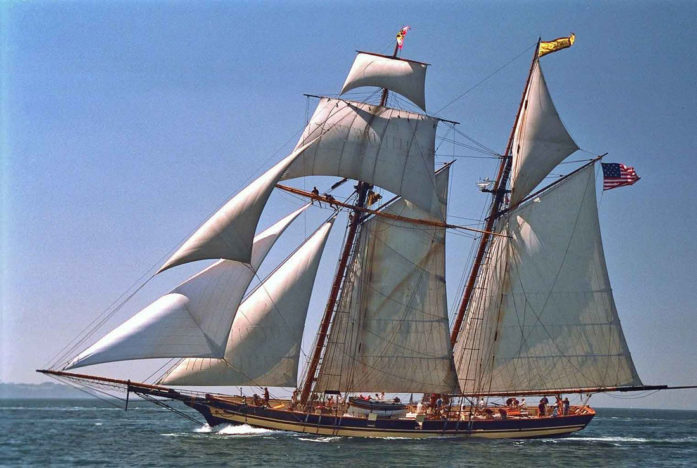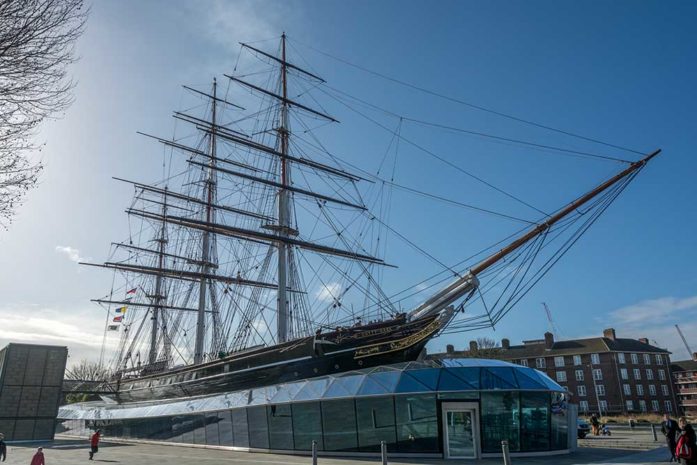After a pause posting in this category, I’m restarting with the clipper, a very quick sail boat which is not in use anymore. The verb “clip” has been coined by the 17th century English bard John Dryden, with the sense of running or flying very quick. Clip became synonymous with speed, hence “clipper”. Not everybody is certain of it as a nautical term until the end of the 18th century.
The Baltimore Clipper
When this new model of vessel was built, which was intended to “clip” over the waves rather than plow through them, the improved type of boat became known as clipper because of its speed. Baltimore clippers were first built as small, fast sailing vessels for trade around the coastlines of the United States and the Caribbean Islands. Their hull lines tended to be very sharp, with a “V”-shaped cross section below the waterline and strongly raked stem, stern posts, and masts. The origins of the type are unknown but certainly hulls conforming to the concept were being built in Jamaica and Bermuda and by the late 18th century were popular both in Britain and the United States (cf. Howard Irving Chapelle, an American naval architect and curator of maritime history at the Smithsonian).

Pride of Baltimore II
[source]
Sailing 150 miles a day was considered a good day’s run in the 1800’s; clippers traveled approximately 250 miles a day. The best clippers could cover more than 400 miles a day, which is more than what a medium modern sailing yacht can cover now. Speed was important to clipper captains because speed meant big profits for the owners and captains.
Thousands of people were eager to get to the California gold fields and would pay premium prices to get there by the fastest clipper ship. Once there, the miners would pay top dollar for the goods and supplies they needed from back east. The ships that brought the goods to California first could earn a fortune for the owners. Tea from China brought a good price in New York and London, but it had to be delivered before it lost its taste. Some enterprising merchants made their fortunes by shipping ice from the ponds and rivers of New England to the tropics where it was a rare and valuable luxury, but they had to get it there before it melted.
Cutty Sark
Alan Viliers (23 September 1903 – 3 March 1982), the Mayflower II commander, says that “to sailors, three things made a ship a clipper. She must be sharp-lined, built for speed. She must be tall-sparred and carry the utmost spread of canvas. And she must use that sail, day and night, fair weather and foul”. Mayflower II is the replica of Mayflower, the 17th-century ship famous for transporting the Pilgrims to the New World.
Cutty Sark is one of only three remaining original composite construction (wooden hull on an iron frame) clipper ships from the nineteenth century in part or whole.

Cutty Sark, the restored British clipper
[source: wikipedia.org]
She was one of the last tea clippers to be built and one of the fastest, coming at the end of a long period of design development, which halted as sailing ships gave way to steam propulsion.
In 1938 Cutty Sark became an auxiliary cadet training ship at the Thames Nautical Training College, alongside HMS Worcester. By 1954, she had ceased to be useful as a cadet ship and was transferred to permanent dry dock at Greenwich, London, for public display.
I hope you like what you read today. A Facebook like for The Yacht Owner will be highly appreciated.
If you like what you read, please subscribe to this blog by completing the form. If you want to help more, start by following us on Twitter, and like our page on Facebook. You don’t know what good things may happen. To lighten your day, check our pins on Pinterest, we can be friends there too. Oh, and if you need a really good looking blog attached to your site, or just for fun, to express your feelings more competitively, read this Own Your Website offer! Thank you very much.

To “clip along” or go “at a fast clip” is probably a turn of phrase first applied to horses, later to vessels. Relatively sharp & fast hulls were being designed for piracy in the Mediterranian, & to combat piracy there, by the late 1600’s or earlier, as blends of the war galley & “round ship” concepts, to carry sail at speed. The characteristics of these designs became known & spread, eventually, to the North American colonies, where both piratical & commercial applications would be realized a century before the term “Baltimore Clipper” was used. By 1800, even the French were building sharp, ship-rigged corvettes with modified “Baltimore Clipper” lines…also before the term was coined. Ann McKim, regarded by some as a “pre-clipper ship” & by others as the “first” clipper ship (keel laid, 1832), was basically an enlarged Baltimore clipper design with sharply-rising floors & relatively little room for cargo. The later clippers had fuller center sections faired to sharp ends. Later vessels used greater size to fair still fuller, longer hulls to sharp ends in the post-clipper era, while sail competed successfully with steam in many trades through the late 1800’s. Commerce interdiction during WWI finally dealt the death blow to surviving commercial sailing fleets, which had remained viable to the end.